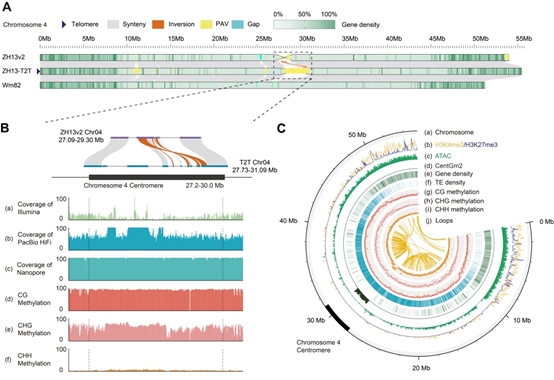On October 6, Prof. Wang Haifeng 's team from Guangxi University, in collaboration with Prof. Chen Qingshan 's team from Northeast Agricultural University, successfully released the complete genome "ZH13-T2T" of the Chinese soybean variety "Zhonghuang 13" (ZH13) and mapped the epigenetic modifications of this soybean variety for the first time. The results of this study were published in Molecular Plant under the title of The T2T Genome Assembly of Soybean Cultivar ZH13 and Its Epigenetic Landscapes, with the State Key Laboratory of Conservation and Utilization of Subtropical Agricultural Bioresources and the School of Agriculture of Guangxi University as the first authors.
The researchers integrated Nanopore ultra-long sequencing, PacBio HiFi sequencing and Hi-C technology to successfully assemble the nearly complete ZH13-T2T genome (Figure A), which filled in the blank regions of the ZH13v2 genome, especially the centromeric and telomeric regions. The authors complemented about 26 Mb of new sequence and corrected 35 inversions and 163 translocations, with most of the structural variations occurring in the centromeric region (Figure B), which provides a solid data base for further study of the functional genome of soybean.

This study not only successfully assembled the T2T genome of the Chinese soybean variety ZH13, but also mapped the first complete epigenetic modification map and analyzed the epigenetic modification characteristics of the complex regions (centromere and telomere) of soybeans, which will greatly contribute to the study of the regulatory network of soybean gene expression as well as the breeding work.
Prof. Wang Haifeng and Prof. Chen Qingshan of Northeastern Agricultural University (NAU) are the corresponding authors of the paper, while Zhang Chao , a doctoral student of Guangxi University, Assistant Professor Xie Liang , Dr. Yu Hang , and Associate Professor Wang Jinhui of Northeastern Agricultural University (NAU) are the co-first authors of the paper. The study was funded by several projects, including the National Key Research and Development Program of China, the National Natural Science Foundation of China, and the Guangxi Natural Science Foundation.